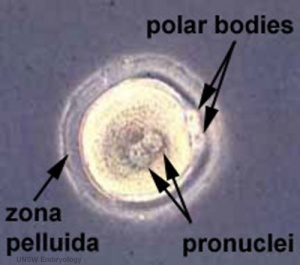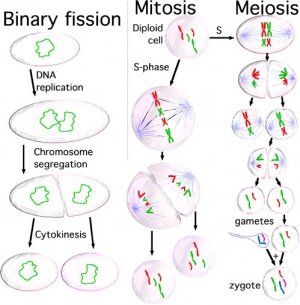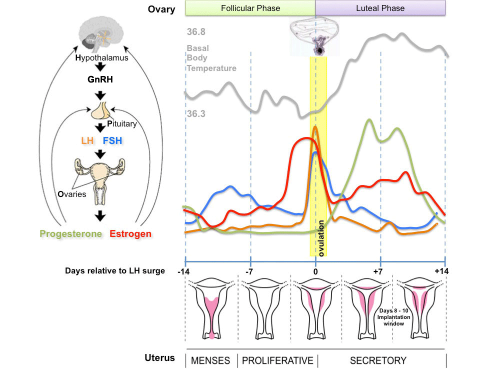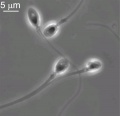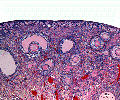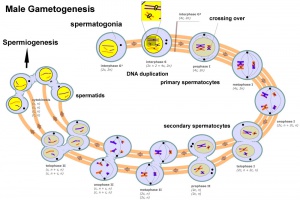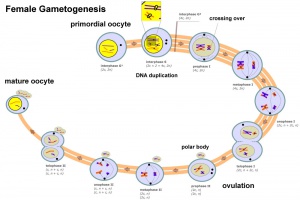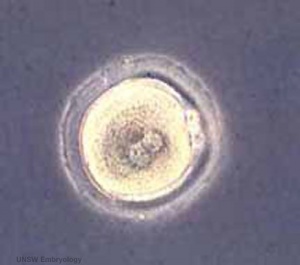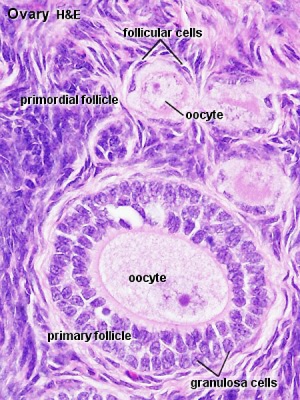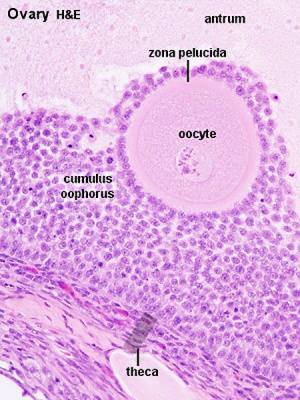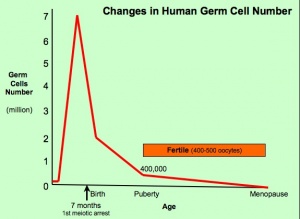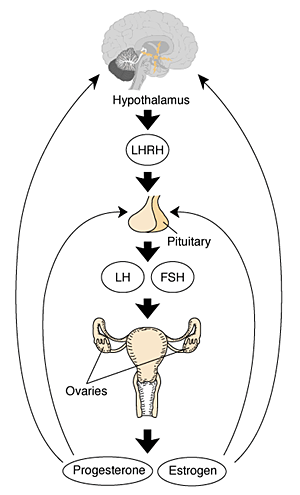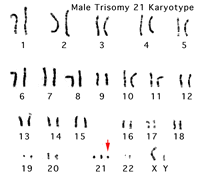Lecture - Fertilization
Introduction
This lecture and the associated laboratory will cover male and female gametogenesis and fertilisation.
Development is 1 embryonic cell producing about 100,000,000,000,000 cells in the adult at any one time (over time with cell death and ongoing replacement this is substantially more).
This is where the first embryonic cell begins! Fertilization is the fusion of haploid gametes, egg (oocyte) and sperm (spermatozoa), to form the diploid zygote. Note though there can be subtle differences in the fertilization process which occurs naturally within the body or through reproductive technologies outside the body, the overall product in both cases is a diplod zygote.
Some Recent Research - Podcast Biosights 18 March 2013 - Breaking egg symmetry
Lecture Objectives
- Broad understanding of reproductive cycles.
- Understand the key features of gametogenesis.
- Understand the differences in male and female gametogenesis.
- Brief understanding of the differences between mitosis and meiosis.
- Understanding of the events in fertilization.
Lecture Resources
| Movies | |||||||||||||||||||||||
|---|---|---|---|---|---|---|---|---|---|---|---|---|---|---|---|---|---|---|---|---|---|---|---|
|
|
|
|
|
| ||||||||||||||||||
|
|
|
|
|
|
| References | ||
|---|---|---|
| Hill, M.A. (2020). UNSW Embryology (20th ed.) Retrieved April 18, 2024, from https://embryology.med.unsw.edu.au |
| |
| Moore, K.L., Persaud, T.V.N. & Torchia, M.G. (2011). The developing human: clinically oriented embryology (9th ed.). Philadelphia: Saunders. | The following chapter links only work with a UNSW connection. | |
| Schoenwolf, G.C., Bleyl, S.B., Brauer, P.R. & Francis-West, P.H. (2009). Larsen's human embryology (4th ed.). New York; Edinburgh: Churchill Livingstone. | The following chapter links only work with a UNSW connection. |
Human Reproductive Cycle
Sexual reproduction in most species is regulated by regular endocrine changes, or cycles, in the female. These cycles begin postnatally, function for variable times and can then decrease or cease entirely.
- Human reproduction is regulated in females by the menstrual cycle, a regular cyclic hormonal change which coordinate changes in the ovary and internal reproductive tract. This cycle commences at puberty and ends at menopause.
- Non-primates (rats, mice, horses, pig) reproduction is regulated in females by the estrous cycle (British spelling, oestrous).
| Female | Male |
|---|---|
|
|
Gametogenesis
Meiosis in the gonad (ovary or testis) produces the haploid gametes, oocyte and spermatozoa (egg and sperm). Meiosis time course and final gamete number differs between female and male.
Male - Spermatogenesis
The testes have two functions.
- produce the male gametes or spermatozoa
- produce male sexual hormone, testosterone (internal and external genitalia, sex characteristics)
Human spermatozoa take about 48 days from entering meiosis until morphologically mature spermatozoa.
Sertoli cells (support cells) Interstitial cells or Leydig cells (produce hormone) |
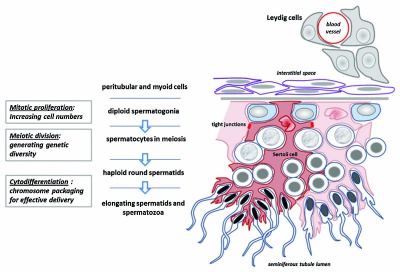
|
Female - Oogenesis
The ovaries have two functions.
- produce the female gametes or oocytes
- produce female hormones, estrogen and progesterone (secondary sex characteristics, menstrual cycle)
In an adult human female the development of a primordial follicle containing an oocyte to a preovulatory follicle takes in excess of 120 days.
Human ovary follicle development
- Ovarian Follicle Stages: primordial follicle - primary follicle - secondary follicle - tertiary follicle - preovulatory follicle
Follicle cells (support cells) Theca cells (produce hormone)
- Links: Spermatozoa Development | Oocyte Development | MBoC - Figure 20-18. Influence of Sry on gonad development | Endocrinology - Comparative anatomy of male and female reproductive tracts
Meiosis Differences
Male Meiosis
- Meiosis initiated continuously in a mitotically dividing stem cell population
- 4 gametes produced / meiosis
- Meiosis completed in days or weeks
- Meiosis and differentiation proceed continuously without cell cycle arrest
- Differentiation of gamete occurs while haploid after meiosis ends
- Sex chromosomes excluded from recombination and transcription during first meiotic prophase
MBoC - Figure 20-27. The stages of spermatogenesis
Female Meiosis
- Meiosis initiated once in a finite population of cells
- 1 gamete produced / meiosis
- Completion of meiosis delayed for months or years
- Meiosis arrested at 1st meiotic prophase and reinitiated in a smaller population of cells
- Differentiation of gamete occurs while diploid in first meiotic prophase
- All chromosomes exhibit equivalent transcription and recombination during meiotic prophase
The Cell - Figure 14.37. Meiosis of vertebrate oocytes
Polar Bodies
- In female gametogenesis only a single (1) haploid egg is produced from meiosis. In male gametogenesis four (4) haploid sperm are produced from meiosis. So what happens to all the extra DNA in producing this single egg?
- In Meiosis 1 the "extra" DNA is excluded to the periphery as a 1st polar body, which encloses the extra DNA.
- In Meiosis 2 the "extra" DNA is once again excluded as a 2nd polar body. The first polar body may also under go meiosis 2 producing a 3rd polar body.
- These polar bodies are not gametes.
- Polar bodies appear to have no other function other than to dispose of the extra DNA in oogenesis.
- Recent research in mice suggest that the position of oocyte polar body may influence fertilization site.
Fertilization
Gamete formation, menstrual cycle and fertilisation will also be covered in detail in this week's Laboratory. Fertilization is the complete process resulting in the fusion of haploid gametes, egg and sperm, to form the diploid zygote. The recent development of aided fertilization is described as in vitro fertilization (in vitro = "in glass", outside the body, IVF). Clinically, all these aided fertilization techniques are grouped as Assisted Reproductive Technologies or ART.
- Oogenesis - 1 gamete produced/meiosis + 3 polar bodies, meiosis is slow, 1 egg produced and released at ovulation
- Spermatogenesis - 4 gametes produced/meiosis, meiosis is fast, 200-600 million sperm released at ejaculation
Fertilization Site
- Fertilization resulting in embryo development usually occurs in first 1/3 of uterine tube (oviduct, Fallopian tube)
- Fertilization can also occur outside uterine tube associated with Assisted Reproductive Technologies (IVF, GIFT, ZIFT...) and ectopic pregnancy
- The majority of fertilized oocytes do not go on to form an embryo
Fertilization - Spermatozoa
- Capacitation - alteration of the spermatozoa metabolism and surface proteins
- Sperm Binding - zona pellucida protein ZP3 acts as receptor for sperm
- Acrosome Reaction - exocytosis of acrosome contents (Calcium mediated) MBoC - Figure 20-31. The acrosome reaction that occurs when a mammalian sperm fertilizes an egg
- enzymes to digest the zona pellucida
- exposes sperm surface proteins to bind ZP2
- Membrane Fusion - between sperm and egg, allows sperm nuclei passage into egg cytoplasm
Fertilization - Oocyte
- Membrane Depolarization - caused by sperm membrane fusion, primary block to polyspermy
- Cortical Reaction - IP3 pathway elevates intracellular Calcium, exocytosis of cortical granules MBoC - Figure 20-32. How the cortical reaction in a mouse egg is thought to prevent additional sperm from entering the egg
- enzyme alters ZP3 so it will no longer bind sperm plasma membrane
- Meiosis 2 - completion of 2nd meiotic division
- forms second polar body (a third polar body may be formed by meiotic division of the first polar body)
Fertilization Preparation
Prior to the fertilization process commencing both the gametes oocyte (egg) and spermatozoa (sperm) require completion of a number of biological processes.
- Oocyte Meiosis - completes Meiosis 1 and commences Meiosis 2 (arrests at Metaphase II).
- Spermatozoa Capacitation - following release (ejaculation) and mixing with other glandular secretions, activates motility and acrosome preparation.
- Migration - both Oocyte and Spermatozoa.
- oocyte ovulation and release with associated cells, from ovary into fimbria then into uterine tube (oviduct, uterine horn, fallopian tube) and epithelial cilia mediated movement.
- spermatozoa ejaculation, deposited in vagina, movement of tail to "swim" in uterine secretions through cervix, uterine body and into uterine tube, have approximately 24-48h to fertilize oocyte.
Endocrinology - Diagram of the comparative anatomy of the male and female reproductive tracts
Oogenesis
Oocyte Development (Oogenesis)
- Process of oogonia mature into oocytes (ova, ovum, egg)
- all oogonia form primary oocytes before birth, therefore a maturation of preexisting cells in the female gonad, ovary
- humans usually only 1 ovum released every menstrual cycle (IVF- superovulation)
- oocyte and its surrounding cells = follicle
- primary -> secondary -> ovulation releases
Ovary- Histology - whole transverse section (cortex, medulla)
Menstrual Cycle
- Primary Oocyte - arrested at early Meiosis 1
- diploid: 22 chromosome pairs + 1 pair X chromosomes (46, XX)
- autosomes and sex chromosome
- Oogenesis- pre-antral then antral follicle (Graafian follicle is mature antral follicle released)
- Secondary oocyte
- 1 Day before ovulation completes (stim by LH) Meiosis 1
- haploid: 22 chromosomes + 1 X chromosome (23, X)
- nondisjunction- abnormal chromosome segregation
- begins Meiosis 2 and arrests at metaphase
- note no interphase replication of DNA, only fertilization will complete Meiosis 2
Ovulation (HPG Axis)
- Hypothalmus releases gonadotropin releasing hormone (GRH, luteinizing hormone–releasing hormone, LHRH) -> Pituitary releases follicle stimulating hormone (FSH) and lutenizing hormone (LH) -> ovary follicle development and ovulation.
- release of the secondary oocyte and formation of corpus luteum
- secondary oocyte encased in zona pellucida and corona radiata
- Ovulation associated with follicle rupture and ampulla movement.
Zona Pellucida
MBoC - Figure 20-21. The zona pellucida
- glycoprotein shell ZP1, ZP2, ZP3
- mechanical protection of egg and involved in the fertilization process
- sperm binding, adhesion of sperm to egg
- acrosome reaction - releases enzymes to locally breakdown
- block of polyspermy
- altered to prevent more than 1 sperm penetrating
- may also have a role in development of the blastocyst
- Links: Zona pellucida
Corona Radiata
- granulosa cells and extracellular matrix
- protective and nutritional role for cells during transport
- cells are also lost during transport along oviduct
Gamete formation- Spermatogenesis
Spermatozoa Development (Spermatogenesis)
- process of spermatagonia mature into spermatazoa (sperm)
- continuously throughout life occurs in the seminiferous tubules in the male gonad- testis (plural testes)
- at puberty spermatagonia activate and proliferate (mitosis)
- primary spermatocyte -> secondary spermatocyte-> spermatid->sperm
- Seminiferous Tubule is site of maturation involving meiosis and spermiogenesis
- Spermatogenesis- Meiosis
- meiosis is reductive cell division
- 1 spermatagonia (diploid) 46, XY (also written 44+XY) = 4 sperm (haploid); 23, X 23, X 23, Y 23, Y
Spermiogenesis
- morphological (shape) change from round spermatids to elongated sperm
- loose cytoplasm
- Transform golgi apparatus into acrosome (in head)
- Organize microtubules for motility (in tail, flagellum)
- Segregate mitochondria for energy (in tail)
Ejaculate
- By volume <10 % sperm and accessory glands contribute majority of volume (60 % seminal vesicle, 10 % bulbourethral, 30 % prostate)
- 3.5 ml, 200-600 million sperm
- Capacitation is the removal of glycoprotein coat and seminal proteins and alteration of sperm mitochondria
- Infertility can be due to Oligospermia, Azoospermia, Immotile Cilia Syndrome
- Oligospermia (Low Sperm Count) - less than 20 million sperm after 72 hour abstinence from sex
- Azoospermia (Absent Sperm) - blockage of duct network
- Immotile Cilia Syndrome - lack of sperm motility
Fertilization Site
- Fertilization usually occurs in first 1/3 of oviduct
- Fertilization can also occur outside oviduct, associated with In Vitro Fertilization (IVF, GIFT, ZIFT...) and ectopic pregnancy
- The majority of fertilized eggs do not go on to form an embryo
Fertilization - Spermatozoa
- Sperm Binding - zona pellucida protein ZP3 acts as receptor for sperm
- Acrosome Reaction - exyocytosis of acrosome contents (Calcium mediated) MBoC - Figure 20-31. The acrosome reaction that occurs when a mammalian sperm fertilizes an egg
- enzymes to digest the zona pellucida
- exposes sperm surface proteins to bind ZP2
- Membrane Fusion - between sperm and egg, allows sperm nuclei passage into egg cytoplasm
Fertilization- Oocyte
- Membrane Depolarization - caused by sperm membrane fusion, primary block to polyspermy
- Cortical Reaction - IP3 pathway elevates intracellular Calcium, exocytosis of cortical granules MBoC - Figure 20-32. How the cortical reaction in a mouse egg is thought to prevent additional sperm from entering the egg
- enzyme alters ZP3 so it will no longer bind sperm plasma membrane
- Meiosis 2 - completion of 2nd meiotic division
- forms second polar body (a third polar body may be formed by meiotic division of the first polar body)
Formation of the Zygote
- Pronuclei - Male and Female haploid nuclei approach each other and nuclear membranes break down
- chromosomal pairing, DNA replicates, first mitotic division
- Sperm contributes - centriole which organizes mitotic spindle
- Oocyte contributes - mitochondria (maternally inherited)
Sex Determination
- based upon whether an X or Y carrying sperm has fertilized the egg, should be 1.0 sex ratio.
- actually 1.05, 105 males for every 100 females, some studies show more males 2+ days after ovulation.
- cell totipotent (equivalent to a stem cell, can form any tissue of the body)
Men - Y Chromosome
- Y Chromosome carries Sry gene, protein product activates pathway for male gonad (covered in genital development)
Women - X Chromosome
- Gene dosage, one X chromosome in each female embryo cell has to be inactivated
- process is apparently random and therefore 50% of cells have father's X, 50% have mother's X
- Note that because men only have 1 X chromosome, if abnormal, this leads to X-linked diseases more common in male that female where bothe X's need to be abnormal.
Abnormalities
- The most common chromosome abnormality is aneuploidy, the gain or loss of whole chromosomes.
- Caused by meiotic nondisjunction, the failure of chromosomes to correctly separate homologues during meiosis I or sister chromatids during meiosis II.
- Down Syndrome - caused by an extra copy of chromosome 21. Abnormal Development - Trisomy 21 (Down Syndrome)
- Chromosomal translocations occur when there is an inappropriate exchange of chromosomal material. Philadelphia chromosome
- Philadelphia chromosome - piece of Chr9 exchanged with Chr22 Generates truncated abl, overstimulates cell production, leads to chronic myelogenous leukemia
UNSW Embryology Links
| Cell Division Links: meiosis | mitosis | Lecture - Cell Division and Fertilization | spermatozoa | oocyte | fertilization | zygote | Genetics |
References
Online Textbooks
- Developmental Biology by Gilbert, Scott F. Sunderland (MA): Sinauer Associates, Inc.; c2000Figure 2.9. Summary of meiosis | fusion of egg and sperm plasma membranes
- Molecular Biology of the Cell 4th ed. Alberts, Bruce; Johnson, Alexander; Lewis, Julian; Raff, Martin; Roberts, Keith; Walter, Peter New York and London: Garland Science; c2002 - IV. Internal Organization of the Cell Chapter 17. The Cell Cycle and Programmed Cell Death Programmed Cell Death | An Overview of the Cell Cycle | Figure 17-1. The cell cycle | Fertilization
- Molecular Cell Biology by Lodish, Harvey; Berk, Arnold; Zipursky, S. Lawrence; Matsudaira, Paul; Baltimore, David; Darnell, James E. New York: W. H. Freeman & Co.; c1999 Chapter 13. Regulation of the Eukaryotic Cell Cycle Regulation of the Eukaryotic Cell Cycle | Overview of the Cell Cycle and Its Control | Figure 13-2. Current model for regulation of the eukaryotic cell cycle | Movies Proposed alternative mechanisms for chromosome congression. | Centromeric attachment of microtubules. | The stages of mitosis and cytokinesis in an animal cell.
- The Cell - A Molecular Approach by Cooper, Geoffrey M. Sunderland (MA): Sinauer Associates, Inc.; c2000- IV. Cell Regulation Chapter 14. The Cell Cycle The Eukaryotic Cell Cycle | Figure 14.1. Phases of the cell cycle | Figure 14.32. Comparison of meiosis and mitosis | Figure 14.37. Meiosis of vertebrate oocytes
- HSTAT - In Vitro Fertilization As A Medical Treatment For Male or Female Infertility
Search
- Bookshelf cell division | mitosis | meiosis | fertilization
- Pubmed cell division | mitosis | meiosis | fertilization
Reviews
<pubmed>18163464</pubmed> <pubmed>17189856</pubmed>
Terms
- diploid - (Greek, di = double + ploion = vessel) Having two sets of chromosomes, the normal state for all cells other than the gametes.
- haploid - (Greek, haploos = single) Having a single set of chromosomes as in mature germ/sex cells (oocyte, spermatozoa) following reductive cell division by meiosis. Normally cells are diploid, containing 2 sets of chromosomes.
- meiosis - The cell division that occurs only in production of germ cells where there is a reduction in the number of chromosomes (diploid to haploid) which is the basis of sexual reproduction. All other non-germ cells in the body divide by mitosis.
- mitosis - The normal division of all cells, except germ cells, where chromosome number is maintained (diploid). In germ cell division (oocyte, spermatozoa) meiosis is a modified form of this division resulting in reduction in genetic content (haploid). Mitosis, division of the nucleus, is followed by cytokinesis the division of the cell cytoplasm and the cytoplasmic contents. cytokinesis overlaps with telophase.
External Links
External Links Notice - The dynamic nature of the internet may mean that some of these listed links may no longer function. If the link no longer works search the web with the link text or name. Links to any external commercial sites are provided for information purposes only and should never be considered an endorsement. UNSW Embryology is provided as an educational resource with no clinical information or commercial affiliation.
- JCB - Movie Collection Mitosis | Cytokinesis
- 2008 ANAT3231 Lecture PDF lecture14-15 1 slide/page (view) | 4 slides/page (print) | 6 slides/page (print) | text (print)
- McGraw-Hill Animation comparing Mitosis and Meiosis
- Salmon Lab Mitosis Movies
- 2014 Course: Week 2 Lecture 1 Lecture 2 Lab 1 | Week 3 Lecture 3 Lecture 4 Lab 2 | Week 4 Lecture 5 Lecture 6 Lab 3 | Week 5 Lecture 7 Lecture 8 Lab 4 | Week 6 Lecture 9 Lecture 10 Lab 5 | Week 7 Lecture 11 Lecture 12 Lab 6 | Week 8 Lecture 13 Lecture 14 Lab 7 | Week 9 Lecture 15 Lecture 16 Lab 8 | Week 10 Lecture 17 Lecture 18 Lab 9 | Week 11 Lecture 19 Lecture 20 Lab 10 | Week 12 Lecture 21 Lecture 22 Lab 11 | Week 13 Lecture 23 Lecture 24 Lab 12
Student Projects - Group 1 | Group 2 | Group 3 | Group 4 | Group 5 | Group 6 | Group 7 | Group 8 | Moodle
Glossary Links
- Glossary: A | B | C | D | E | F | G | H | I | J | K | L | M | N | O | P | Q | R | S | T | U | V | W | X | Y | Z | Numbers | Symbols | Term Link
Cite this page: Hill, M.A. (2024, April 18) Embryology Lecture - Fertilization. Retrieved from https://embryology.med.unsw.edu.au/embryology/index.php/Lecture_-_Fertilization
- © Dr Mark Hill 2024, UNSW Embryology ISBN: 978 0 7334 2609 4 - UNSW CRICOS Provider Code No. 00098G
